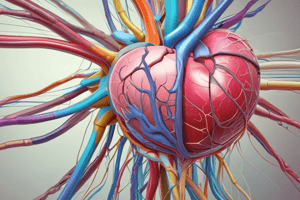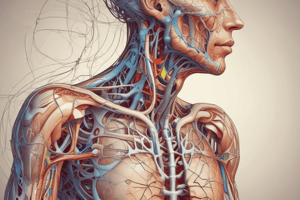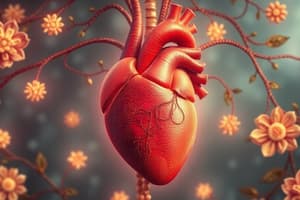Podcast
Questions and Answers
What is the function of the internodal pathway in the heart?
What is the function of the internodal pathway in the heart?
- To regulate blood pressure in the atrioventricular node
- To route the direction of electrical signals so the heart contracts from apex to base (correct)
- To set the pace of the heartbeat at 70 bpm
- To coordinate contraction of the atrioventricular bundle
Which structure sets the pace of the heartbeat at 70 bpm?
Which structure sets the pace of the heartbeat at 70 bpm?
- AV node
- SA node (correct)
- Purkinje fibers
- Ventricular septum
Under what conditions can the AV node and Purkinje fibers act as pacemakers?
Under what conditions can the AV node and Purkinje fibers act as pacemakers?
- Atrial contraction completion
- AV node delay with slower conductional signals through nodal cells (correct)
- SA node malfunction
- Ventricular septum blockage
What is the role of the Purkinje fibers in the heart?
What is the role of the Purkinje fibers in the heart?
What are the primary sites of exchange between blood and interstitial fluid?
What are the primary sites of exchange between blood and interstitial fluid?
Which cells are associated with capillaries and contribute to capillary impermeability?
Which cells are associated with capillaries and contribute to capillary impermeability?
What is the driving pressure for blood flow reflected by?
What is the driving pressure for blood flow reflected by?
How is Mean Arterial Pressure (MAP) calculated?
How is Mean Arterial Pressure (MAP) calculated?
What aids venous return?
What aids venous return?
What determines mean arterial pressure?
What determines mean arterial pressure?
What is responsible for removing excess fluid volume?
What is responsible for removing excess fluid volume?
Which blood vessels act as a volume reservoir?
Which blood vessels act as a volume reservoir?
What measures the strength of the pressure wave produced by ventricular contraction?
What measures the strength of the pressure wave produced by ventricular contraction?
What are the smallest blood vessels?
What are the smallest blood vessels?
What is the primary cell type in capillary walls?
What is the primary cell type in capillary walls?
What contributes to capillary impermeability?
What contributes to capillary impermeability?
What is the volume of blood pumped per contraction known as?
What is the volume of blood pumped per contraction known as?
What causes the second heart sound (dup) in the cardiac cycle?
What causes the second heart sound (dup) in the cardiac cycle?
What does the Electrocardiogram (ECG) represent?
What does the Electrocardiogram (ECG) represent?
When does atrial systole occur in the cardiac cycle?
When does atrial systole occur in the cardiac cycle?
What determines the cardiac output (CO)?
What determines the cardiac output (CO)?
What is the first heart sound (lub) produced by in the cardiac cycle?
What is the first heart sound (lub) produced by in the cardiac cycle?
What is the average cardiac output (CO) value per minute?
What is the average cardiac output (CO) value per minute?
What does the Wiggers diagram illustrate?
What does the Wiggers diagram illustrate?
What represents the completion of ventricular filling in the cardiac cycle?
What represents the completion of ventricular filling in the cardiac cycle?
When does ventricular ejection occur in the cardiac cycle?
When does ventricular ejection occur in the cardiac cycle?
What is the cardiac cycle primarily concerned with?
What is the cardiac cycle primarily concerned with?
What does the pressure-volume curve represent in the cardiac cycle?
What does the pressure-volume curve represent in the cardiac cycle?
Which division modulates heart rate through parasympathetic and sympathetic control?
Which division modulates heart rate through parasympathetic and sympathetic control?
What influences end-diastolic volume (EDV) and stroke volume?
What influences end-diastolic volume (EDV) and stroke volume?
What determines afterload and ejection fraction?
What determines afterload and ejection fraction?
Which factor influences stroke volume by affecting muscle length and norepinephrine?
Which factor influences stroke volume by affecting muscle length and norepinephrine?
What is the state of partial contraction in most blood vessels?
What is the state of partial contraction in most blood vessels?
Which structures contain smooth muscle, elastic and fibrous connective tissue, and endothelium?
Which structures contain smooth muscle, elastic and fibrous connective tissue, and endothelium?
What are metarterioles and precapillary sphincters responsible for?
What are metarterioles and precapillary sphincters responsible for?
What type of vessels act as pressure reservoirs?
What type of vessels act as pressure reservoirs?
Which division involves intricate interactions between the nervous and endocrine systems?
Which division involves intricate interactions between the nervous and endocrine systems?
What is the primary control of heart rate under normal conditions?
What is the primary control of heart rate under normal conditions?
What is the spontaneous depolarization rate of the SA node when both sympathetic and parasympathetic inputs are blocked called?
What is the spontaneous depolarization rate of the SA node when both sympathetic and parasympathetic inputs are blocked called?
What influences contractility by increasing it with positive inotropes and decreasing it with negative inotropes?
What influences contractility by increasing it with positive inotropes and decreasing it with negative inotropes?
Study Notes
Autonomic Control of Heart Rate and Factors Influencing Stroke Volume
- The autonomic division modulates heart rate through parasympathetic and sympathetic control, with parasympathetic activity normally dominating.
- Tonic control involves the spontaneous depolarization rate of the SA node when both sympathetic and parasympathetic inputs are blocked.
- Multiple factors influence stroke volume, including contractility, length-tension relationships, and the Frank-Starling law of the heart.
- Venous return, affected by skeletal muscle contractions and pressure changes in abdominal and thoracic veins, influences end-diastolic volume (EDV) and stroke volume.
- Contractility, influenced by norepinephrine and muscle length, is not the same as the length-tension relationship, but both affect stroke volume.
- Contractility is controlled by the nervous and endocrine systems, with positive inotropes increasing contractility and negative inotropes decreasing it.
- Afterload, determined by EDV and arterial resistance during ventricular contraction, and ejection fraction, determine stroke volume.
- The walls of blood vessels contain smooth muscle, elastic and fibrous connective tissue, and the inner layer is endothelium, which regulates blood pressure and vessel growth.
- Arteries act as pressure reservoirs and have thick layers of vascular smooth muscle, while arterioles are sites of variable resistance and are less elastic and more muscular.
- Metarterioles are branches of arterioles with a partial smooth muscle layer and precapillary sphincters that open and close to direct blood flow.
- Vascular smooth muscle in blood vessels can cause vasoconstriction and vasodilation, and muscle tone is a state of partial contraction in most blood vessels.
- The autonomic control of heart rate and the factors influencing stroke volume are complex and involve intricate interactions between the nervous and endocrine systems, as well as the properties of cardiac and vascular structures.
Studying That Suits You
Use AI to generate personalized quizzes and flashcards to suit your learning preferences.
Related Documents
Description
Test your knowledge of the autonomic control of heart rate and factors influencing stroke volume with this quiz. Explore topics such as parasympathetic and sympathetic control, factors influencing stroke volume, venous return, contractility, afterload, and vascular smooth muscle function. Gain insights into the intricate interactions between the nervous and endocrine systems, as well as the properties of cardiac and vascular structures.




